Creating Cyclists: Start ’em Young
TweetIn promoting cycling for transportation worldwide most of the discussion and action tends to focus on getting adults on bikes, particularly for that very American concept of “commuting” a considerable distance from home to work. Here in the Netherlands cycling for transportation just means generally getting around by bicycle. It’s mostly short distances since people tend to live much closer to work or school. Few would consider cycling greater distances unless it’s just for fun; Urbanites would instead take a train and country folk would most likely drive.
Here cyclists are mostly created from birth, both by example and by teaching kids to ride bikes at a very young age. Below is our story of our son P1 who now at the tender age of 2 1/2 is quite comfortable on a real pedal bike without “training wheels”. With a sample of one it’s certainly not scientifically proven but friends and customers have also had success with the same methods. So without further ado, here’s a timeline of P1’s development as a cyclist (so far). Please note that not all of the pictures show P1 at the age the activity actually begun:
1. One month: Riding as passenger in the bakfiets
It’s debatable whether feeling the motions of cycling from a very early age contribute toward one’s inclination toward cycling, or their development of balance months later. But P1 visibly enjoyed riding in the bike, watching the sights and sky go by. As young as four or five months old we were taking him on longer cycling trips, for example along the Amstel river as in the photo above. The bike is our very popular Cargobike Long.
2. Eight months: Riding as passenger up front on normal bike
We normally state nine months as the time to begin carrying a child in the front seat. P1 was already highly mobile and had been sitting securely for quite some time at eight months so we started a little earlier. Again it’s debatable how much this relatively passive activity contributes to the later development of cycling skills but my educated guess is that riding in the front seat of a parent’s bike is so much like cycling that there must be some learning involved. Kids are like sponges for knowledge and skills and here they’re seeing and feeling the world from exactly the same perspective as the cyclist; the dynamics of cycling, the sights of the city, the interactions with other road users. They even learn how to use the bike’s controls; P1 began pulling on the brake levers, twisting the shifter and ringing the bell within a year or so. Sometimes it’s terribly cute but other times it’s a little annoying to have a signal turn green only to find yourself in the bike’s heaviest gear with a little hand pulling the front brake lever as hard as possible.
3. Always: Generally having a lot of freedom
It seems that the Dutch or at least Amsterdammers give their kids a lot of freedom to play and explore. We often travel with our kids and elsewhere people are amazed or shocked to see a little one crawling around while we rest along a hiking trail, climbing big kid’s structures at a playground, or pushing a little shopping cart though the supermarket. Are they well behaved and playing safely because we’ve allowed them the freedom to learn, or are we just lucky to have a couple well behaved kids? Perhaps mostly the latter but really I cannot say. It is clear though that the local kids are given more space than kids elsewhere, and spend much less time strapped into strollers and the back seats of cars. To my untrained eye these 2-5 year olds seem more physically mature, at least with respect to the activities we see such as riding bikes and kick scooters, and climbing in playgrounds.
4. 12 months: Riding a baby bakfiets
I bought this tiny, antique, wooden bakfiets two years ago on Queen’s Day for €5.00. Since then my son and countless other kids have enjoyed it. P1 began riding it about when he began walking thus about a year old. It’s really tiny and maneuverable and that makes a big difference; Kids have to feel comfortable with these “toys”. I really believe that the ergonomics influence their experience and learning curve considerably. The lesson: Get little vehicles that fit and work properly and that are light enough for the child to have fun with. If necessary tinker a little to lower a seat so so your child get her feet on the ground, or shorten a handlebar because the manufacturer didn’t bother to do so. Most of the little bikes and trikes our kids use have been modified in some simple ways.
After a few months P1 would tear around the bikes at Workcycles Jordaan shop on the little bakfiets, skidding the rear wheel or intentionally flipping it, giggling as he rolled across the floor. Probably once or twice he hurt himself enough to cry but I honestly cannot remember it.
5. 18 months: Riding a Micro Mini scooter
P1’s first experience in riding a wheeled vehicle requiring balance was with the Micro Mini Scooter. The box says ages three and up but that must just be to please the lawyers of the firm’s American distributor. Even much younger kids love riding these little kick scooters. At a year and a half P1 made his first tentative steps around the shop (with the handlebar at about eye level) and gradually developed his skills on it. A few months later he would speed through the store, surfing through the parked bikes. What’s great about the Micro Mini is that it’s a three wheeler with the behavior of a two wheeler. At rest it stands up so a child can easily begin pushing around on it. But it steers by leaning with very natural dynamics so to really ride it one must develop the same balance skills as cycling. It also folds up to carry in a bike basket or backpack and weighs approximately nothing.
6. 25 months: Riding a balance bike
Once P1 was comfortable on the kick scooter I figured he could also ride a balance bike. He wanted to try it but even the smallest model (the Micro G Bike) was too tall for him at 18-19 months. I made the mistake of encouraging him to try anyway but then he fell off several times, got frustrated and refused to go near it for the following half year. Even lowering it my installing smaller wheels and dressing it up as a motorcycle (like many little boys he’s fascinated with motorcycles) didn’t help:
Then one day at about 25 months old he just stepped over the G-Bike and pushed off. Already having months of experience on both the little bakfiets and the kick scooter it was only a few minutes before he was gliding through the shop this time.
P1 became inseparable from his balance bike which has been really handy for mom and dad. He rides it to the store, to the park, and the whole day alongside us as we go about our business in the city. Rarely do we need to carry him. He’s much faster on the bike than Kyoko walking with P2 in the stroller or on our backs so he stops and rides up and down steps or practices other tricks while mom catches up. We’ve even dropped him into the local skate/BMX bike bowl to copy the tricks he sees the big kids doing.
7. 32 months: Riding a real bike without pedals (without training wheels)
He only did this for a few hours and I didn’t think to take a picture. To ease the transition from balance bike to bigger and heavier “real” bike I removed the pedals and let P1 ride around for an afternoon. He knew exactly what was going on and was totally psyched to ride his “real BMX bike”. Not only did this help P1 get used to the bike, it also gave me an opportunity to adjust the handlebars and saddle for him. Even at their lowest adjustments both saddle and handlebar were too high. I shortened the seat post and cut a couple centimeters off the top of the seat tube to lower the saddle. The handlebar was far too high so I fashioned an adapter to clamp it at the crossbar instead of at the normal spot. I would have just replaced the handlebar with a lower one but this stem has strange dimensions.
Note that this bike never had nor will have “training wheels”. That’s because training wheels actually hinder the process of learning to ride a bike.
A little about the bike itself:
I did quite a bit of research into the available kid’s bikes with 12″ wheels before buying. Almost of the bikes in this size are really awful; badly “designed”, crudely made and shockingly heavy with terrible bearings, covered in tasteless graphics. In fact the only decent 12″ bike I found was this Specialized Hot Rock 12. It has an aluminium frame, rims and handlebar, good quality tires and fairly tasteful graphics. By no means is it perfect. The cheap, steel cranks are much too wide forcing P1 to pedal like a duck (if a duck could pedal, that is) and the handlebar and stem are too tall and have nonstandard dimensions. It weighs 7kg without the training wheels which we never used. That seems light for us but really isn’t light for a 12kg rider. For comparison sake his Micro G-Bike weighs just 2kg.
8. 32 months: Riding a real bike
A few days later we brought the “real BMX bike” to the Vondelpark, this time with the pedals installed. P1 wasn’t so happy about this development so first we flipped the bike upside down and made a game of “pedal”… “brake”… “pedal”… “brake”. That was fun so then we did the same with him on the bike, me supporting the bike from the saddle while he pedaled and braked his way around the park. I gradually held the bike more and more lightly and after a few minutes he continued pedaling (and balancing) alone. After all P1 had long since developed the skills to ride the bike.
The following weekend P1 did a few laps around the big Westerpark and really became more relaxed on his bike. Though kids learn to ride young here it’s still rather strange to see such a small child riding a bike. Thus P1 gets an incredible number of stares, “awwww look, how cute”s, and “How did you do that? My child is four and still can’t ride a two-wheeler.”s
So now P1 can ride a bike but actually he still prefers his balance bike. Each day when we head out together I ask him which bike he wants and he always chooses the G-Bike. Why? Because it’s smaller and lighter and more fun. P1 can toss it around, try doing wheelies, carry it up steps, fall off it painlessly. That little bike is to him what a BMX or trials bike is to a big kid. And I’m very happy about that; I’ve had the proud papa moments of seeing my 2 year old ride a real bike yet we can still go about the city with his much lighter and easier to carry (in the basket of my own bike for example) balance bike.
I wish you the same success making your own little ones into happy cyclists!

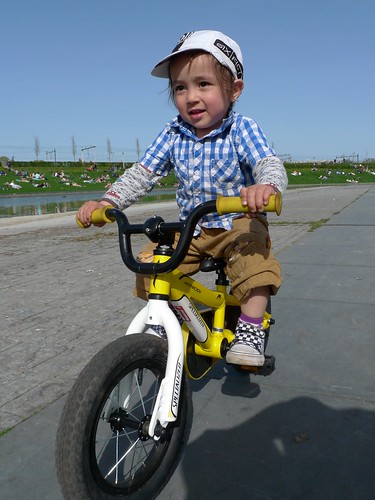
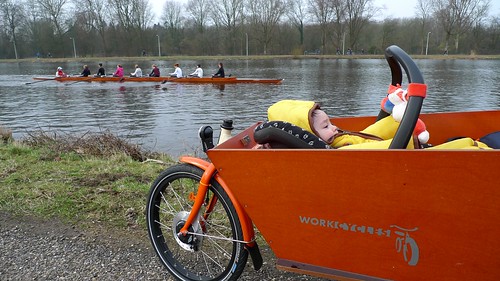
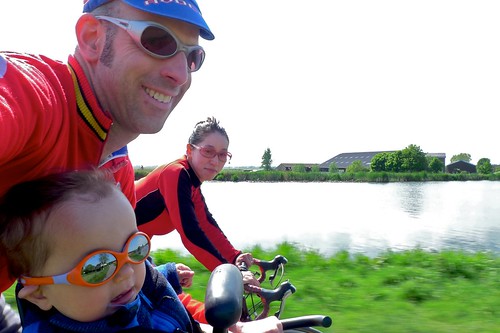
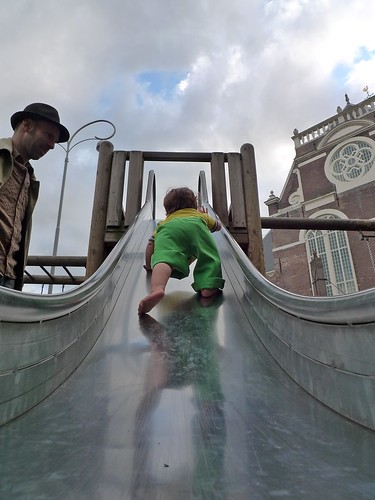

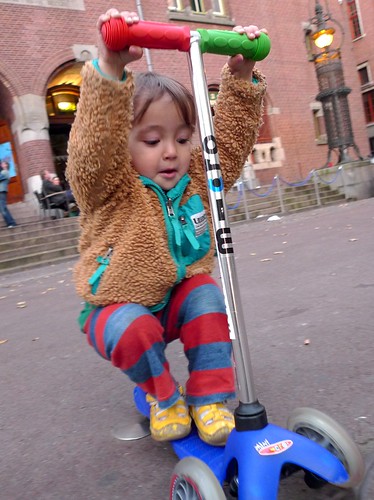

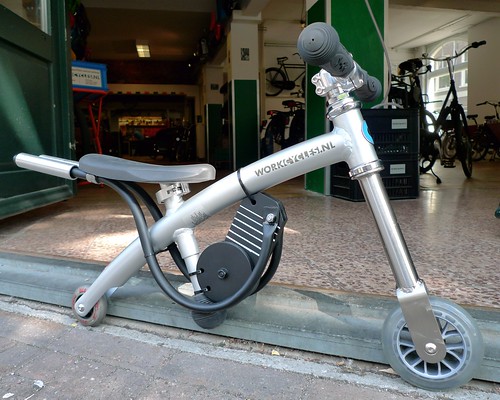
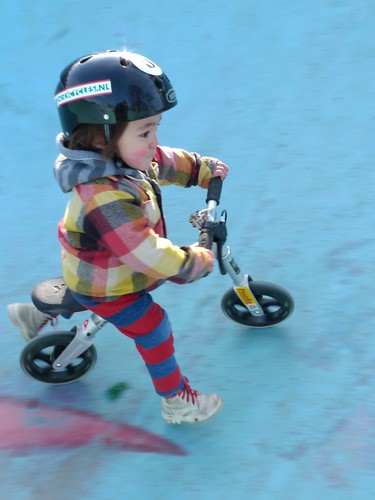

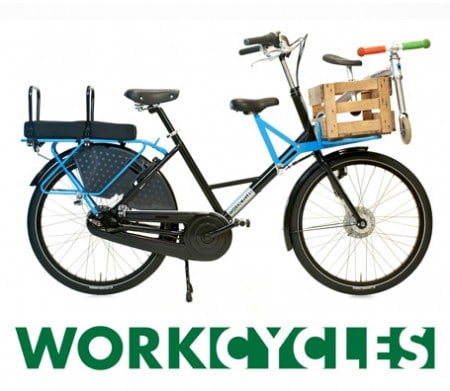
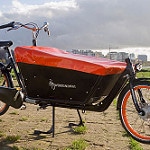















April 26th, 2013 at 22:01
Hi Edwin,
How cool that you’re little boy already wants to ride the run bike. I put a standard inline skate wheel in the back. I don’t remember the exact diameter but it was probably a 76mm or 80mm wheel, thus lowering the seat at least a centimeter.
I didn’t do the front wheel for two reasons: Firstly the size of the rear wheel has much more influence on the saddle height and secondly a smaller front wheel gets stuck in cracks and little holes.
May 17th, 2013 at 16:38
Dear Henry,
We just wanted to say a big ThankYou for the advice you gave us about lightweight cycles for kids. It has been about a month since we entered your shop on Lijnbaansgracht hoping to fix our son’s Micro scooter and also try all available kids’ cycles hoping to buy Lenny a bike for his 4th birthday. Our everyday nursery run was 1 mile each way (first done with a pram, then on a scooter, then on a balancing bike and finally on a 12″ bicycle). You advised us to try an Islabike.
Unaccustomed to the price range we attempted to save a bit and bought a second hand 14″ Islabike that unfortunately had a clunky bottom bracket. But it was really light and Lenny loved it from the first sight. Since I could not fix the BB myself, I sent it back to where it came from, took a deep breath, and we ordered a brand new 16″ Islabike directly from the factory.
Lenny simply loves it! The new bike has acquired many names, including “the Fast bike”, “the school bike” etc. A few days ago he rode a total of 12km during one day which also included other physical activities. The future looks bright 🙂
Best regards,
Leo and Daria (happy parents)
PS: we are still considering FollowMe tandem attachment that you suggested, too.
June 21st, 2013 at 03:25
My first born lad is almost 4 and has mastered his 3-wheeler scooter. Time to get him a balance bike (as he has well and truly pushed the limits of that particular, plastic toy) and Henry’s words above merely hammer that idea home. I only wish I’d done it sooner.